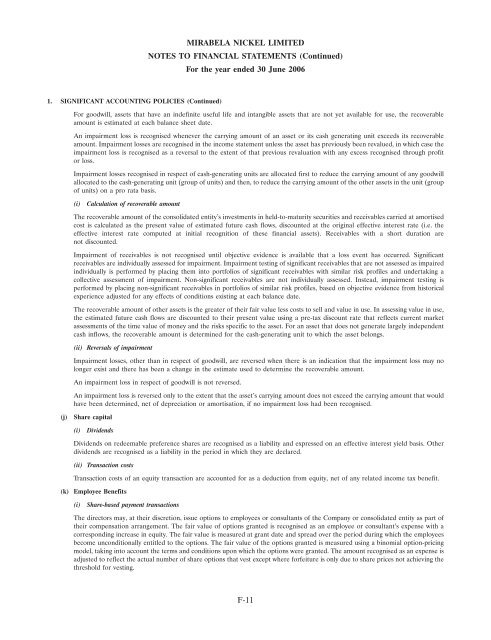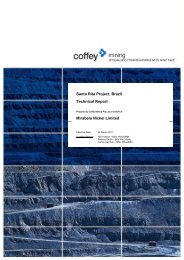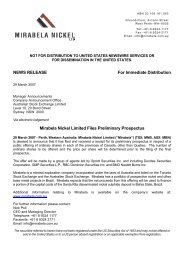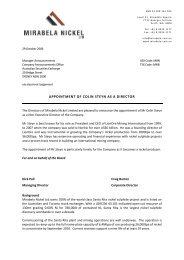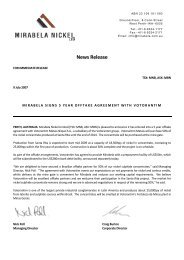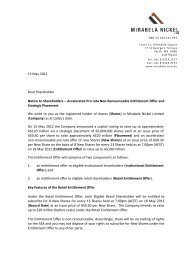COPY OF FINAL PROSPECTUS - Mirabela Nickel
COPY OF FINAL PROSPECTUS - Mirabela Nickel
COPY OF FINAL PROSPECTUS - Mirabela Nickel
Create successful ePaper yourself
Turn your PDF publications into a flip-book with our unique Google optimized e-Paper software.
MIRABELA NICKEL LIMITED<br />
NOTES TO FINANCIAL STATEMENTS (Continued)<br />
For the year ended 30 June 2006<br />
1. SIGNIFICANT ACCOUNTING POLICIES (Continued)<br />
For goodwill, assets that have an indefinite useful life and intangible assets that are not yet available for use, the recoverable<br />
amount is estimated at each balance sheet date.<br />
An impairment loss is recognised whenever the carrying amount of an asset or its cash generating unit exceeds its recoverable<br />
amount. Impairment losses are recognised in the income statement unless the asset has previously been revalued, in which case the<br />
impairment loss is recognised as a reversal to the extent of that previous revaluation with any excess recognised through profit<br />
or loss.<br />
Impairment losses recognised in respect of cash-generating units are allocated first to reduce the carrying amount of any goodwill<br />
allocated to the cash-generating unit (group of units) and then, to reduce the carrying amount of the other assets in the unit (group<br />
of units) on a pro rata basis.<br />
(i)<br />
Calculation of recoverable amount<br />
The recoverable amount of the consolidated entity’s investments in held-to-maturity securities and receivables carried at amortised<br />
cost is calculated as the present value of estimated future cash flows, discounted at the original effective interest rate (i.e. the<br />
effective interest rate computed at initial recognition of these financial assets). Receivables with a short duration are<br />
not discounted.<br />
Impairment of receivables is not recognised until objective evidence is available that a loss event has occurred. Significant<br />
receivables are individually assessed for impairment. Impairment testing of significant receivables that are not assessed as impaired<br />
individually is performed by placing them into portfolios of significant receivables with similar risk profiles and undertaking a<br />
collective assessment of impairment. Non-significant receivables are not individually assessed. Instead, impairment testing is<br />
performed by placing non-significant receivables in portfolios of similar risk profiles, based on objective evidence from historical<br />
experience adjusted for any effects of conditions existing at each balance date.<br />
The recoverable amount of other assets is the greater of their fair value less costs to sell and value in use. In assessing value in use,<br />
the estimated future cash flows are discounted to their present value using a pre-tax discount rate that reflects current market<br />
assessments of the time value of money and the risks specific to the asset. For an asset that does not generate largely independent<br />
cash inflows, the recoverable amount is determined for the cash-generating unit to which the asset belongs.<br />
(ii) Reversals of impairment<br />
Impairment losses, other than in respect of goodwill, are reversed when there is an indication that the impairment loss may no<br />
longer exist and there has been a change in the estimate used to determine the recoverable amount.<br />
An impairment loss in respect of goodwill is not reversed.<br />
An impairment loss is reversed only to the extent that the asset’s carrying amount does not exceed the carrying amount that would<br />
have been determined, net of depreciation or amortisation, if no impairment loss had been recognised.<br />
(j)<br />
Share capital<br />
(i)<br />
Dividends<br />
Dividends on redeemable preference shares are recognised as a liability and expressed on an effective interest yield basis. Other<br />
dividends are recognised as a liability in the period in which they are declared.<br />
(ii) Transaction costs<br />
Transaction costs of an equity transaction are accounted for as a deduction from equity, net of any related income tax benefit.<br />
(k) Employee Benefits<br />
(i)<br />
Share-based payment transactions<br />
The directors may, at their discretion, issue options to employees or consultants of the Company or consolidated entity as part of<br />
their compensation arrangement. The fair value of options granted is recognised as an employee or consultant’s expense with a<br />
corresponding increase in equity. The fair value is measured at grant date and spread over the period during which the employees<br />
become unconditionally entitled to the options. The fair value of the options granted is measured using a binomial option-pricing<br />
model, taking into account the terms and conditions upon which the options were granted. The amount recognised as an expense is<br />
adjusted to reflect the actual number of share options that vest except where forfeiture is only due to share prices not achieving the<br />
threshold for vesting.<br />
F-11


